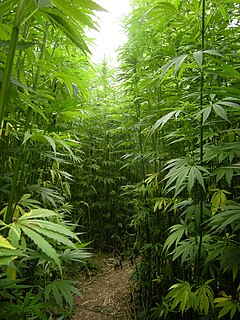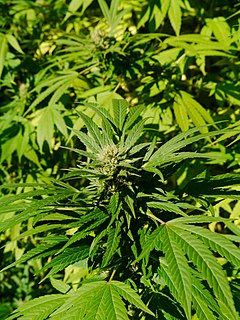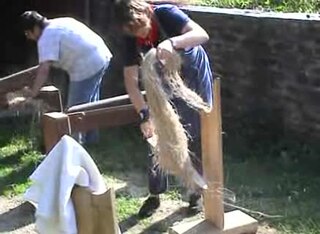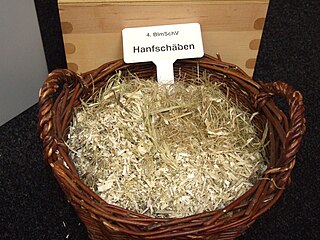 W
WHemp, or industrial hemp, is a variety of the Cannabis sativa plant species that is grown specifically for industrial use. It can be used to make a wide range of products. Along with bamboo, hemp is one of the fastest growing plants on Earth. It was also one of the first plants to be spun into usable fiber 50,000 years ago. It can be refined into a variety of commercial items, including paper, rope, textiles, clothing, biodegradable plastics, paint, insulation, biofuel, food, and animal feed.
 W
WLa Canebière is the historic high street in the old quarter of Marseille, France.
 W
WCannabis indica is an annual plant in the family Cannabaceae. It is a putative species of the genus Cannabis. Whether it and Cannabis sativa are truly separate species is a matter of debate. The Cannabis indica plant is cultivated for many purposes; for example, the plant fibers can be converted into cloth. Cannabis indica produces large amounts of tetrahydrocannabinol (THC). The higher concentrations of THC provide euphoric effects making it popular for use both as a recreational and medicinal drug.
 W
WCannabis sativa is an annual herbaceous flowering plant indigenous to Eastern Asia but now of cosmopolitan distribution due to widespread cultivation. It has been cultivated throughout recorded history, used as a source of industrial fiber, seed oil, food, recreation, religious and spiritual moods and medicine. Each part of the plant is harvested differently, depending on the purpose of its use. The species was first classified by Carl Linnaeus in 1753. The word "sativa" means things that are cultivated.
 W
WCharlotte's Web is a brand of high-cannabidiol (CBD), low-tetrahydrocannabinol (THC) products derived from industrial hemp marketed as dietary supplements and cosmetics under federal law of the United States. It is produced by Charlotte's Web, Inc. in Colorado. Hemp-derived products do not induce the psychoactive "high" typically associated with recreational marijuana strains that are high in THC. Charlotte's Web hemp-derived products contain less than 0.3% THC.
 W
WThe use of cannabis as a recreational drug has been outlawed in many countries for several decades. As a result of long-fought legalization efforts, several countries such as Uruguay and Canada, as well as several states in the US, have legalized the production, sale, possession, and recreational and/or medical usage of cannabis. The broad legalization of cannabis in this fashion can have numerous effects on the economy and society in which it is legalised.
 W
WThe Hanfparade is a hemp legalization demonstration in Berlin. It has taken place each year in August since 1997.
 W
WThe Hash, Marihuana & Hemp Museum is a museum located in De Wallen, Amsterdam, Netherlands. According to the museum, more than two million visitors have visited the exhibition since it opened in 1985. Dedicated to cannabis and its many uses, the museum offers visitors information about the historical and modern uses of cannabis for medicinal, spiritual and cultural purposes. The museum also focuses on how hemp can be used for agricultural and industrial purposes, even including clothing accessories and cosmetic products made from hemp fiber in their gift shop. In 2012 the museum opened a second location in Barcelona, the Hash Marihuana Cáñamo & Hemp Museum.
 W
WHemp for Victory is a black-and-white United States government film made during World War II and released in 1942, explaining the uses of hemp, encouraging farmers to grow as much as possible. During World War II, the Marihuana Tax Act of 1937 was lifted briefly to allow for hemp fiber production to create ropes for the U.S. Navy but after the war hemp reverted to its de facto illegal status.
 W
WSambe, or hemp fiber, is a traditional fiber for Korean clothing. The knowledge of weaving sambe skillfully is being lost, has been deemed a national treasure, and specific individuals with the ability were designated intangible cultural assets. Sambe was the primary textile fiber used in clothing for commoners prior to the introduction of cotton to Korea in the late 15th century. A particularly fine variety is andongpo from Andong, North Gyeongsang Province.
 W
WScutching is a step in the processing of cotton or the dressing of flax or hemp in preparation for spinning. The scutching process separates the impurities from the raw material, such as the seeds from raw cotton or the straw and woody stem from flax fibers. Scutching can be done by hand or by a machine known as a scutcher. Hand scutching of flax is done with a wooden scutching knife and a small iron scraper. The end products of scutching flax are the long finer flax fibers called line, short coarser fibers called tow, and waste woody matter called shives.
 W
WShives, also known as shoves or boon, are the wooden refuse removed during processing flax, hemp, or jute, as opposed to the fibres (tow). Shives consist of "the woody inner portion of the hemp stalk, broken into pieces and separated from the fiber in the processes of breaking and scutching" and "correspond to the shives in flax, but are coarser and usually softer in texture". Shives have traditionally been a by-product of fiber production.
 W
WStanding Silent Nation is a 2006 documentary film about Alex White Plume, a resident of South Dakota's Pine Ridge Reservation. After a great deal of research, Alex and his family planted industrial hemp, under the incorrect assumption that tribal sovereignty laws would allow the production of this non-psychoactive relative of marijuana, and the film details the consequences of his actions.
 W
WWeed World Candies sells lollipops. The lollipops are marketed and sold in vans across the United States. With advertising on the vans depicting cannabis plants next to lollipops, strong euphemism suggests a cannabis flavor or the possibility of intoxication after eating the lollipops. The candy sold from the vans does not contain THC.
 W
WXuan paper, or Shuen paper or rice paper, is a kind of paper originating in ancient China used for writing and painting. Xuan paper is renowned for being soft and fine textured, suitable for conveying the artistic expression of both Chinese calligraphy and painting.